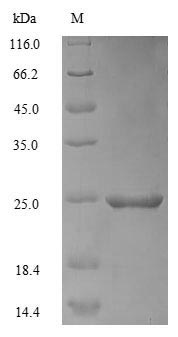Recombinant Mouse Apolipoprotein C-III (Apoc3)
In Stock-
货号:CSB-EP001933MO
-
规格:¥1836
-
图片:
-
其他:
产品详情
-
纯度:Greater than 90% as determined by SDS-PAGE.
-
基因名:
-
Uniprot No.:
-
别名:Apoc3Apolipoprotein C-III; Apo-CIII; ApoC-III; Apolipoprotein C3
-
种属:Mus musculus (Mouse)
-
蛋白长度:Full Length of Mature Protein
-
来源:E.coli
-
分子量:24.9kDa
-
表达区域:21-99aa
-
氨基酸序列EEVEGSLLLGSVQGYMEQASKTVQDALSSVQESDIAVVARGWMDNHFRFLKGYWSKFTDKFTGFWDSNPEDQPTPAIES
Note: The complete sequence including tag sequence, target protein sequence and linker sequence could be provided upon request. -
蛋白标签:N-terminal 6xHis-SUMO-tagged
-
产品提供形式:Liquid or Lyophilized powder
Note: We will preferentially ship the format that we have in stock, however, if you have any special requirement for the format, please remark your requirement when placing the order, we will prepare according to your demand. -
缓冲液:Tris-based buffer,50% glycerol
-
储存条件:Store at -20°C/-80°C upon receipt, aliquoting is necessary for mutiple use. Avoid repeated freeze-thaw cycles.
-
保质期:The shelf life is related to many factors, storage state, buffer ingredients, storage temperature and the stability of the protein itself.
Generally, the shelf life of liquid form is 6 months at -20°C/-80°C. The shelf life of lyophilized form is 12 months at -20°C/-80°C. -
货期:3-7 business days
-
注意事项:Repeated freezing and thawing is not recommended. Store working aliquots at 4°C for up to one week.
-
Datasheet & COA:Please contact us to get it.
相关产品
靶点详情
-
功能:Component of triglyceride-rich very low density lipoproteins (VLDL) and high density lipoproteins (HDL) in plasma. Plays a multifaceted role in triglyceride homeostasis. Intracellularly, promotes hepatic very low density lipoprotein 1 (VLDL1) assembly and secretion; extracellularly, attenuates hydrolysis and clearance of triglyceride-rich lipoproteins (TRLs). Impairs the lipolysis of TRLs by inhibiting lipoprotein lipase and the hepatic uptake of TRLs by remnant receptors. Formed of several curved helices connected via semiflexible hinges, so that it can wrap tightly around the curved micelle surface and easily adapt to the different diameters of its natural binding partners.
-
基因功能参考文献:
- Both triglyceride-rich lipoproteins (TRLs) and ApoCIII contribute to the progression of atherosclerosis, and the modulation of TRLs and ApoCIII may represent a novel therapeutic approach against hypertriglyceridemia induced atherosclerosis. PMID: 30223835
- C3(QK) variant is a gain-of-function mutation that can stimulate VLDL1 production, through enhanced DNL PMID: 28887372
- intestinal apoC-III overexpression results in the secretion of smaller, less dense chylomicron particles along with reduced triacylglycerol secretion from the intestine PMID: 28159868
- ApoC-III inhibits turnover of TG-rich lipoproteins primarily through a hepatic clearance mechanism mediated by the LDLR/LRP1 axis PMID: 27400128
- These data strongly suggest that intestinal apoC-III is not a FoxO1 target and support the idea that apoC-III is not regulated coordinately with hepatic apoC-III, and establishes another key aspect of apoC-III that is unique in the intestine from the liver. PMID: 28739253
- APOC3, whose dysregulation is liable for hypertriglyceridemia, is not a predisposing factor for linking overnutrition to NAFLD in obesity PMID: 28115523
- Severe hypertriglyceridaemia resulting from ApoCIII overexpression promotes restenosis and atherosclerosis PMID: 26160324
- Under conditions of islet insulin resistance, locally produced apoCIII is an important diabetogenic factor involved in impairment of beta-cell function. PMID: 25941406
- decreased ApoAI synthesis might be accounted for the lower plasma HDL level in ApoCIII transgenic mice PMID: 25969427
- ApoCIII hyperactivates beta cell CaV1 channels through SR-BI/beta1 integrin-dependent coactivation of PKA and Src. PMID: 23949443
- Increased plasma APOC3 concentrations predispose mice to diet-induced nonalcoholic fatty liver and hepatic insulin resistance. PMID: 21793029
- Glucose induces apoCIII transcription, which may represent a mechanism linking hyperglycemia, hypertriglyceridemia, and cardiovascular disease in type 2 diabetes. PMID: 21183731
- PGC-1beta regulates plasma triglyceride metabolism through stimulating apolipoprotein C3 (APOC3) expression and elevating APOC3 levels in circulation PMID: 20889132
- The apoC-III metabolism may contribute to dyslipidemia in CKD, and this requires further investigation. PMID: 19542564
- Association between SstI polymorphism of the gene, glucose intolerance and cardiovascular risk in renal transplant recipients PMID: 11959336
- ApoB lipoproteins that contain apoCIII increase THP-1 cell adhesion to ECs via PKCalpha and RhoA-mediated beta1-integrin activation. PMID: 16461842
- oxidized fatty acids may act through an APOA5/APOClll mechanism that contributes to lowering of TG levels other than PPAR* induction PMID: 18243209
- the apoCIII enhancer contributes to the maintenance of an active chromatin subdomain of the apoAI/CIII/AIV genes, but not apoAV PMID: 18678879
- These results suggest that apoC-III may play a specific role in lipid storage and mobilization in adipocytes, non-lipoprotein-secreting cells, and indicate the functional role of RXRalpha during adipocyte differentiation. PMID: 19121312
显示更多
收起更多
-
亚细胞定位:Secreted.
-
蛋白家族:Apolipoprotein C3 family
-
数据库链接:
KEGG: mmu:11814
STRING: 10090.ENSMUSP00000034586
UniGene: Mm.390161
Most popular with customers
-
Recombinant Human Cannabinoid receptor 1 (CNR1)-VLPs (Active)
Express system: Mammalian cell
Species: Homo sapiens (Human)
-
Recombinant Human Transferrin receptor protein 1 (TFRC), partial (Active)
Express system: Mammalian cell
Species: Homo sapiens (Human)
-
Recombinant Macaca fascicularis CUB domain containing protein 1 (CDCP1), partial (Active)
Express system: Mammalian cell
Species: Macaca fascicularis (Crab-eating macaque) (Cynomolgus monkey)
-
-
Recombinant Human Urokinase-type plasminogen activator(PLAU) (Active)
Express system: Mammalian cell
Species: Homo sapiens (Human)


















